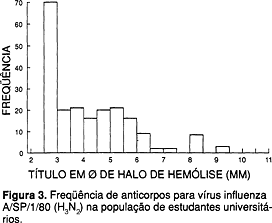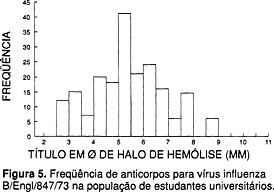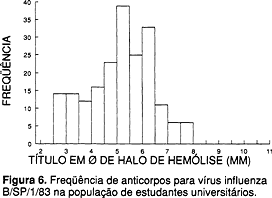Wide serological prevalence of influenza A and B was verified by the serological survey covering 200 students of the University of S. Paulo during the 1984-1985 period. The humoral antibodies were detected by the single radial haemolysis technique, whose arithmetic titres averages were greater for both subtypes, (H1N1) and (H3N2) of the influenza A virus strains recently isolated from the population. However, the situation of this type B virus was not the same as that of type A seeing that the B/Engl/ 847/73, although an older strain, showed better reactogenicity than the other strains evaluated. It is possible that is was responsible for the primo infection of most of the components of the group surveyed, as the phenomenon of the "Original Antigenic Sin" explains. The antibody responses to subtypes of influenza A and B in this survey demonstrated levels with low SRH titres (2.5 to 3.5 mm) and high SRH titres (> 4.0mm) related to the lowest and highest levels of suggest protection against infection. Individual immunity and persistence of antibody are related to frequency and recent occurrence of exposition to influenza. As concerns the formulation of influenza vaccine it was established that this preserves the antigen selection of the new strains isolated from the population, mainly due to the behavior of the influenza A virus.
Influenza; Seroepidemiologic methods







